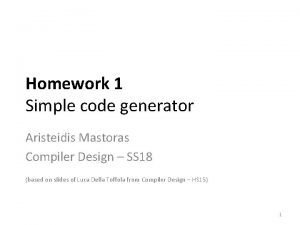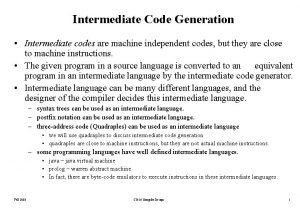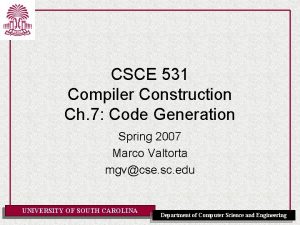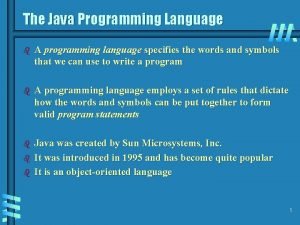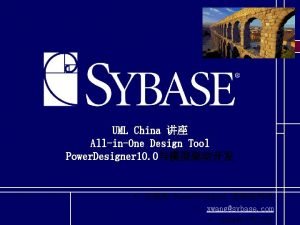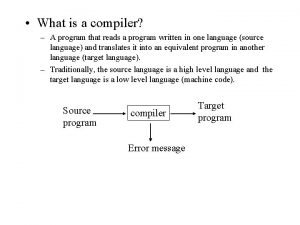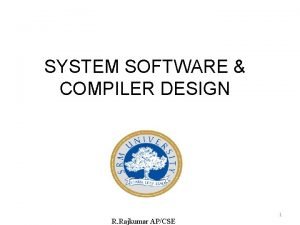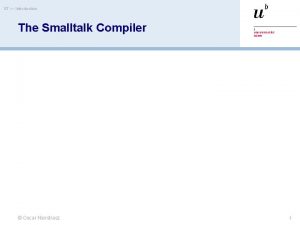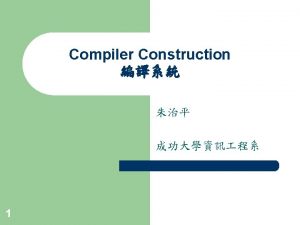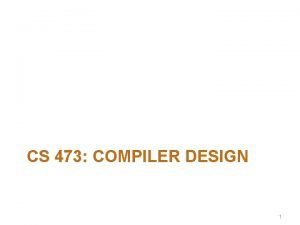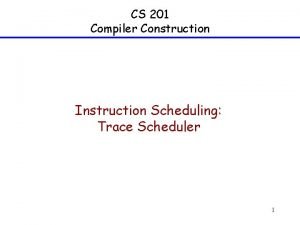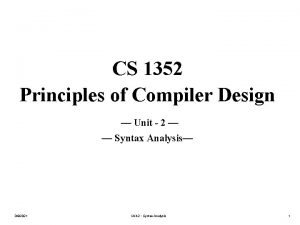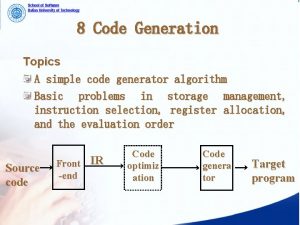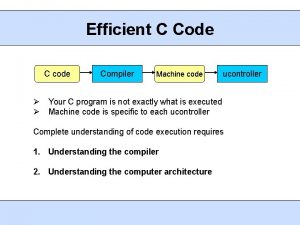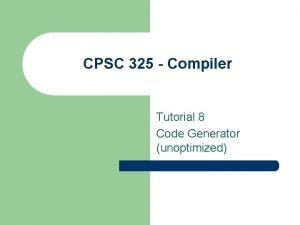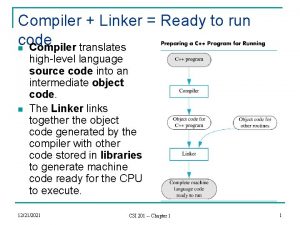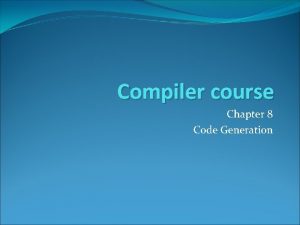Homework 1 Simple code generator Aristeidis Mastoras Compiler




























































- Slides: 60

Homework 1 Simple code generator Aristeidis Mastoras Compiler Design – SS 18 (based on slides of Luca Della Toffola from Compiler Design – HS 15) 1

Administrative issues • Has everyone found a teammate? • Mailing-list: cd 1@lists. inf. ethz. ch – Please subscribe if we forgot you • Assistants: cd 1 -owner@lists. inf. ethz. ch 2

Today HW Overview SVN Javali HW 1 3

Today HW Overview SVN Javali HW 1 4

This course Build a full Javali compiler Lexical Analysis Syntax Analysis Semantic Analysis Code Generation 5

This course HW 2 Lexical Analysis Syntax Analysis Semantic Analysis Code Generation Parser 6

This course HW 3 Lexical Analysis Syntax Analysis Semantic Analysis Code Generation 7

This course HW 4 Lexical Analysis Syntax Analysis Semantic Analysis Code Generation 8

This course Global optimizations or Javali advanced features HW 6 Lexical Analysis Syntax Analysis Semantic Analysis Code Generation 9

Homework 1 Lexical Analysis Syntax Analysis Semantic Analysis Code Generation 10

Homework 1 Variable declarations Assignments Simple expressions Lexical Analysis Syntax Analysis Semantic Analysis Code Generation 11

Homework 1 Variable declarations Assignments Simple expressions Lexical Analysis Syntax Analysis Semantic Analysis Code Generation We give you the parser 12

Homework 1 Variable declarations Assignments Simple expressions Lexical Analysis Syntax Analysis Semantic Analysis Code Generation Not necessary for now 13

Grading • Homework task – The compiler “works” • Write your own tests – Test exhaustively that the compiler works • Code quality – The code is readable 14

Grading • Indication of your grade • Link will be announced 15

Good news! • HW 1 is independent of HW 2 • The same applies to the next HW • You can still do the next HW even if you don’t manage to get this right 16

Today HW Overview SVN Javali HW 1 17

SVN What is SVN? • a version control system • it is used to store current and previous versions of (not only) source code • you can revert to a previous version 18

Javali fragment We provide: • a compiler skeleton for every HW • stored in an SVN repository • every team has a different SVN repository 19

Get your fragment https: //svn. inf. ethz. ch/svn/trg/cd_students/ss 18/teams/<Your. Team> Case-sensitive Homework + grades Your submission platform 20

SVN basics svn checkout https: //<your_SVN_repo> Get the remote copy of the repository on your machine. svn commit –m “Message about your changes” Update remote copy of the repository with local changes. svn update Get remote changes of your repository if modified. 21

SVN basics svn add <file-or-dir-name> Add a file/directory to the local copy. (It requires commit to update the remote copy. ) svn remove <file-or-dir-name> Delete a file/directory from the local copy. (It requires commit to update the remote copy. ) 22

SVN basics svn status Report files that are different in the local copy from those in the remote copy. svn diff –r <version-number> <file-name> Report the differences between the local copy and a specific version. 23

SVN resources Links – http: //svnbook. red-bean. com – https: //www. google. ch/search? q=svn+tutorial Software – Eclipse Subversive – Tortoise SVN – Command-line 24

Today HW Overview SVN Javali HW 1 25

Javali • Simple OO programming language – Subset of Java • Javali specification in the course web-site – Updated recently, subject to changes (and bugs) • When the specification is incomplete – Common sense or Java specification apply – Use the mailing-list for clarifications or questions 26

Javali framework • We provide a framework skeleton – To use for your homework – Utility classes and basic tasks – Free to modify or create your own – Please comply to submission requirements • After each homework we provide a solution 27

Javali framework src Source of the compiler test Source files for testing your compiler lib Compiler dependencies as. JAR files javali_tests Unit-tests in form of. javali files. These are example programs to test build. xml Optional ANT script for command-line (can be used in Eclipse) 28

Compile the Javali framework Fragment is an Eclipse project, it will build automatically If you don’t use Eclipse, install ANT and type: ant test It compiles automatically too 29

How to test your Javali compiler • We provide a JUnit-based testing framework • A test is a Javali program in the javali_tests directory • The testing framework compares the output of your compiler against our reference solution To test your compiler write more Javali programs that cover assignment tasks You need to see green 30

How to test your Javali compiler • Expected results are stored in. javali. exec. ref files • . javali. in file determines the standard input – One line is equivalent to the result of a read() call. • Run the tests using JUnit 4 – Eclipse provides a GUI to inspect results • . javali. err file contains debugging output and error messages 31

DEMO 32

Javali framework changes Files that may change per fragment • lib/frozen. Reference. jar @ every fragment • build. xml depending on the assignment – We will provide details in the recitation – Look for new targets • Javali specification – As previously mentioned 33

Today HW Overview SVN Javali HW 1 34

Simple code generator Input: Javali Program class Main { void main() { int a; a = 10; write(a); } } Output: x 86 Assembly. section. data STR_D: . string "%d" . section. data var_a: . int 0. section. text . globl main: … 35

Simple code generator class Main { void main() { int a; a = 10; write(a); } } ? main: … # Emitting a = 10 # Emitting 10 movl $10, %edi movl %edi, var_a # Emitting write(a) # Emitting a movl var_a, %edi sub $16, %esp movl %edi, 4(%esp) movl $STR_D, 0(%esp) call printf add $16, %esp … 36

Javali program representation The Intermediate Representation of Javali compiler is an Abstract Syntax Tree class Main { void main() { int a; a = 10; write(a); } } Class. Decl Method. Decl Seq Var. Decl Assign Var Built. In. Write Int. Const Var We give you the IR, i. e. , the AST. You need to generate the assembly code by using the AST. 37

Another example Input: Javali Program Output: x 86 Assembly main: . . . # Emitting a = 10 # Emitting 10 movl $10, %edi movl %edi, var_a class Main { void main() { int a, b; a = 10; b = a + 7; } } = b + a 7 # Emitting b = (a + 7) # Emitting 7 movl $7, %edi # Emitting a movl var_a, %esi add %edi, %esi movl %esi, var_b . . . 38

Javali Abstract Syntax Tree abstract classes Ast Decl Stmt Expr … … … concrete classes for nodes used from the IR Ast nodes declared in cd/ir/Ast. java 39

Javali Abstract Syntax Tree Declarations Class. Decl, Method. Decl, Var. Decl Statements Assign, Built. In. Writeln, If. Else, Method. Call, While. Loop, Nop Expressions Var, Int. Const, Unary. Op, Binary. Op, Built. In. Read, Index, New. Array, Field, Cast, Null. Const, This. Ref, New. Object, Boolean. Const 40

Javali Abstract Syntax Tree Declarations Class. Decl, Method. Decl, Var. Decl Only a subset of the AST nodes are used in Homework 1 Statements Assign, Built. In. Writeln, If. Else, Method. Call, While. Loop, Nop Expressions Var, Int. Const, Unary. Op, Binary. Op, Built. In. Read, Index, New. Array, Field, Cast, Null. Const, This. Ref, New. Object, Boolean. Const 41

Print the Abstract Syntax Tree • We provide a utility class to print the AST – cd/util/debug/Ast. Dump. java • To check the AST for a test program – Examine the. parser. ref file, or the. err file. • All AST nodes also have a to. String() method 42

DEMO 43

Traverse the Abstract Syntax Tree How can we traverse the AST? Similarly to a (binary) tree. 44

Traverse a binary tree • How can we traverse a binary tree? public class Visitor { void visit(Tree. Node node) { if (node. leftchild != null) visit(node. leftchild); 1 2 3 5 4 6 7 if (node. rightchild != null) visit(node. rightchild); } } 45

Traverse a binary tree • What if different nodes have different colors and different behavior? • Blue nodes: print “blue” • Green nodes: print “green” 46

Traverse a binary tree abstract class Tree. Node { public Tree. Node leftchild; public Tree. Node rightchild; … } class Blue. Node extends Tree. Node { … } class Green. Node extends Tree. Node { … } 47

Traverse a binary tree public class Visitor { void visit(Tree. Node node) { if (node instanceof Blue. Node) print “blue”; Add node-specific else if (node instanceof Green. Node) behavior print “green”; } } if (node. leftchild != null) visit(node. leftchild); if (node. rightchild != null) visit(node. rightchild); 48

Traverse a binary tree • This simple solution works well. • But, there are more elegant solutions. • Usage of design patterns. 49

Design patterns … are descriptions of communicating objects and classes customized to solve a general design problem in a particular context Gamma et al. Design Patterns Elements of Reusable Object. Oriented Software 50

Design patterns Wikipedia says: • It is a general reusable solution to a commonly occurring problem within a given context in software design • It is a description or template for how to solve a problem that can be used in many different situations 51

Design patterns • There are many design patterns • Patterns are related and can be combined – Design good software is an art – We may need multiple “tools” to solve a problem • Examples of patterns that can be useful to build your compiler – (and that you may find in our reference solution) 52

Design patterns - Visitor Intent Defines an operation for an object structure. Description • Separates an algorithm from an object structure • Does not change the structure • Does not change class interface(s) • Supports distinct unrelated operations 53

Visitor design pattern solution class Blue. Node extends Tree. Node { void accept(Visitor v) { v. blue. Node(this); We define a method } accept() for each node. } class Green. Node extends Tree. Node { void accept(Visitor v) { v. green. Node(this); } } The accept method calls the proper method of the visitor class. 54

Visitor design pattern solution public class Visitor { public void blue. Node(Blue. Node node) { print “blue”; if (node. leftchild != null) node. leftchild. accept(this); if (node. rightchild != null) node. rightchild. accept(this); } } public void green. Node(Green. Node node) { print “green”; if (node. leftchild != null) node. leftchild. accept(this); if (node. rightchild != null) node. rightchild. accept(this); } 55

DEMO 56

Traverse the Abstract Syntax Tree • Javali framework implements two main visitors to traverse the AST: – Expr. Visitor<R, A> for Expressions – Ast. Visitor<R, A> for Statements and Declarations Generic parameters R = result A = argument Apply an operation for each AST node • Avoid to modify AST class 57

Traverse the Abstract Syntax Tree Two visitors for the code generator: • Expr. Generator extends Expr. Visitor<Register, Void> • Stmt. Generator extends Ast. Visitor<Register, Void> 58

Traverse the Abstract Syntax Tree You can implement another Visitor to traverse the AST of an expression: • calculate the required number of registers • e. g. , 7 * (a + 1) * 7 + a 1 59

HW 1 summary • • • Implementation of simple code generator No stack frame necessary Use. data section slots for each variable Look for throw new To. Do. Exception() Use registers for intermediate results Use optimal number of registers 60
 Yacc tutorial
Yacc tutorial Cross compiler in compiler design
Cross compiler in compiler design Ess
Ess Homework oh homework i hate you you stink
Homework oh homework i hate you you stink Homework oh homework i hate you you stink
Homework oh homework i hate you you stink Parts of a poem
Parts of a poem Homework i love you poem
Homework i love you poem Alitteration definition
Alitteration definition Consonance
Consonance Busceral
Busceral What is a manifestor human design
What is a manifestor human design Intermediate code example
Intermediate code example Compiler code generation
Compiler code generation Java interpreter
Java interpreter Type system in compiler design
Type system in compiler design Response code generator
Response code generator Honda immobilizer brake code generator
Honda immobilizer brake code generator Code generation adalah
Code generation adalah Code documentation generator
Code documentation generator Uml china
Uml china Bliqr
Bliqr Tft dice odds
Tft dice odds Simple future past
Simple future past Past simple future simple
Past simple future simple Present simple present continuous past simple future simple
Present simple present continuous past simple future simple Present simple present continuous past simple future simple
Present simple present continuous past simple future simple Simple present, simple past, simple future
Simple present, simple past, simple future Present continuous present simple exercises
Present continuous present simple exercises Walk simple past tense
Walk simple past tense Definition simple present
Definition simple present Present simple past simple future simple
Present simple past simple future simple Thesis statement generator
Thesis statement generator Code élaboré code restreint
Code élaboré code restreint Managed and unmanaged code
Managed and unmanaged code Apa itu assembler
Apa itu assembler Difference between source code and machine code
Difference between source code and machine code Code switching
Code switching Trace the code genetic code table
Trace the code genetic code table Dsl compiler
Dsl compiler What is compiler
What is compiler Sub division of run time memory
Sub division of run time memory Advantages of absolute loader
Advantages of absolute loader Lexeme in compiler design
Lexeme in compiler design Lance compiler
Lance compiler Language processor
Language processor Syntax analysis in compiler design
Syntax analysis in compiler design Sma compiler
Sma compiler Rose compiler framework
Rose compiler framework Modelon compiler
Modelon compiler Cousins of compiler
Cousins of compiler Cross compilers
Cross compilers Borland compiler
Borland compiler Cousins of compiler
Cousins of compiler Front end of compiler
Front end of compiler Explain front end and back end of compiler
Explain front end and back end of compiler Differences between compiler and interpreter
Differences between compiler and interpreter Pengertian compiler dan interpreter
Pengertian compiler dan interpreter Assembler, compiler and interpreter
Assembler, compiler and interpreter Cs 473
Cs 473 Trace scheduling
Trace scheduling Terminal and non terminal in compiler design
Terminal and non terminal in compiler design


